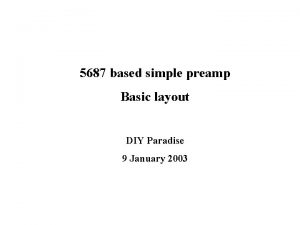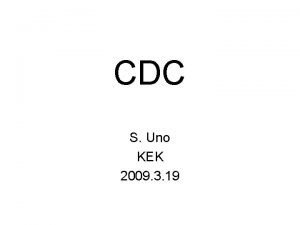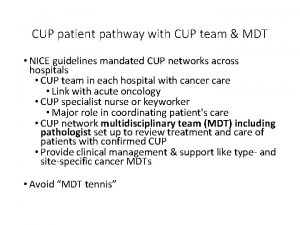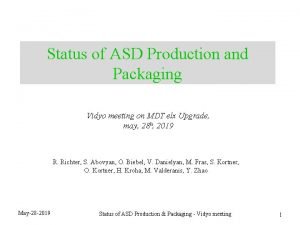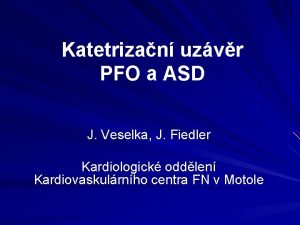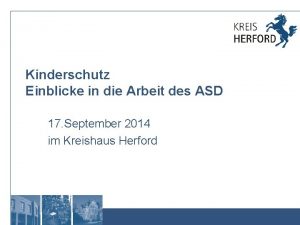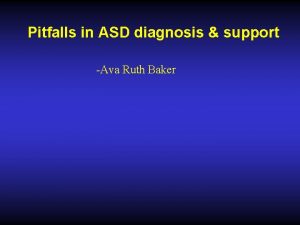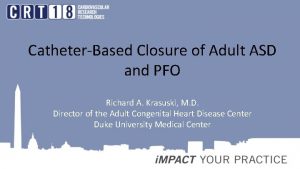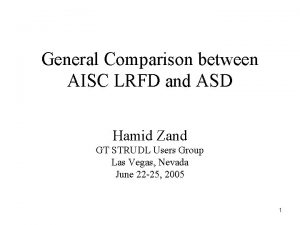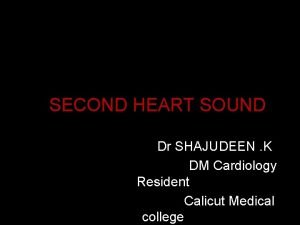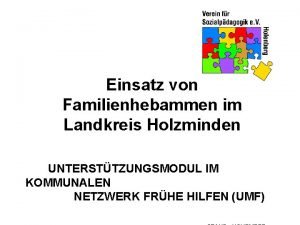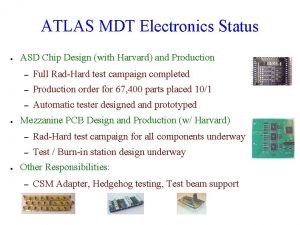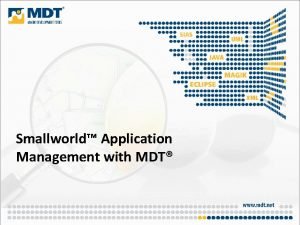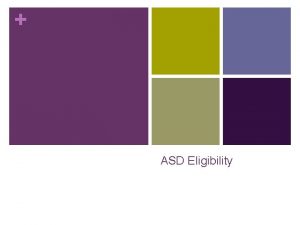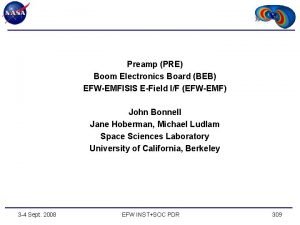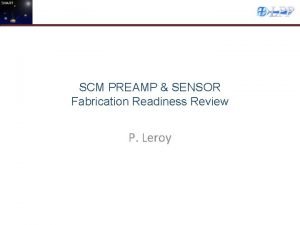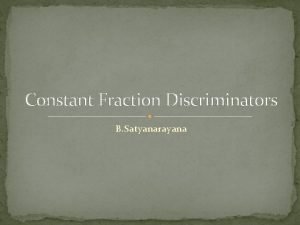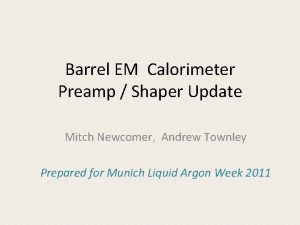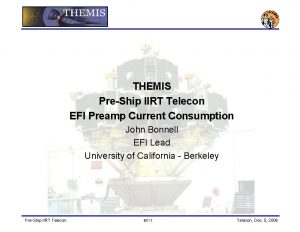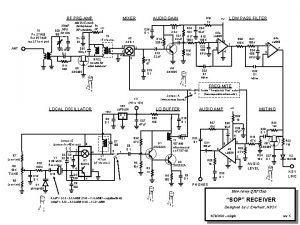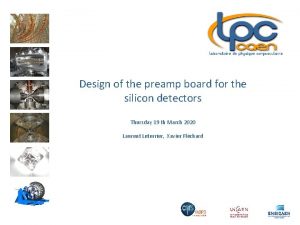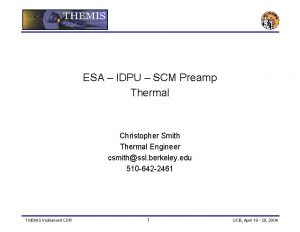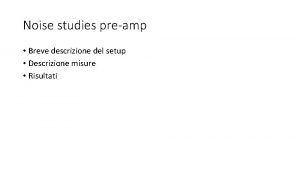Status of the ASD preamp for MDT RO



















![ADC vs. run-down current code: improved Max. width: 170+-50 ns ADC pulse width[ns] ch ADC vs. run-down current code: improved Max. width: 170+-50 ns ADC pulse width[ns] ch](https://slidetodoc.com/presentation_image/164aeec54d94cc37e4dca8c3a204d631/image-20.jpg)

![Power consumption vs. Vcc Power [m. W] • 600 • 550 • 500 • Power consumption vs. Vcc Power [m. W] • 600 • 550 • 500 •](https://slidetodoc.com/presentation_image/164aeec54d94cc37e4dca8c3a204d631/image-22.jpg)
![Peak at Monitor output [m. V] Gain matching between different ASDv 5 chips Input Peak at Monitor output [m. V] Gain matching between different ASDv 5 chips Input](https://slidetodoc.com/presentation_image/164aeec54d94cc37e4dca8c3a204d631/image-23.jpg)






- Slides: 29

Status of the ASD preamp for MDT R/O in Phase-II Preliminary Design Review, sept. , 05, 2017 Robert Richter, MPI Munich

People involved S. Abovyan, V. Danielyan, M. Fras, O. Kortner, H. Kroha, B. Weber*, Y. Zhao, RR Max-Planck-Institute for Physics, Munich A. Baschirotto, M. de Matteis, F. Resta University of Milano-Bicocca C. Valderanis LMU Munich * 05 -sept-2017 now at the INTEL corporation, Germany PDR of the ASDv 6 chip for MDT Readout R. Richter 2

Early history of the ASD The ASD in Agilent 500 nm technology (J. Oliver, C. Posch, E. Hazen) 1997 -2001 development of a 4 -channel version („ASD-lite“) 2001 -2003 development of the final 8 -channel version 2004 production of 50 k packaged chips test of threshold spread of the 8 channels/ASD leads to 3 categories (< 12, <16, <20 m. V) rad-tol tests up to 1 Mrad revealed no failures the lvds-driver allows for logically undefined levels causing the „pair-mode problem“ in the TDC 2007 -2015 good operation experience in „edge mode“, very low failure rate of ASDs 05 -sept-2017 PDR of the ASDv 6 chip for MDT Readout R. Richter 3

History of the New ASD in 130 nm technology 2008 prototype of the analog part only of a 4 -channel version („ASD-lite“) good matching (1, 5%) of shape and gain among channels peaking time ~ 25 ns instead of ~15 ns 2009 prototype of analog + digital part of a 4 -ch. vs. failure: strong digital-analog coupling due to insufficient insulation 2010 2 nd attempt of analog + digital part of 4 -ch vs. no digital-analog coupling, but Wilkinson ADC not functional peaking time remains ~ 25 ns instead of ~15 ns 2013 cooperation between MPI and the Univ. Milano in-depth analysis of risetime, Wilkinson and lvds driver problem design changes to reduce parasitic capacitances redesign of Wilkinson and lvds driver pass all simulation tests: SPICE, PLX, LVS, „corner“ tests (PVT) 2014 submission of ASDv 4 in november 2014 2016 submission of ASDv 5 in aug 2016 2017 submission of ASDv 6 in aug 2017 (2 versions) submission of ASDv 7 in nov 2017 05 -sept-2017 PDR of the ASDv 6 chip for MDT Readout R. Richter 4

Looking at the ASDv 5 with a microscope 2. 26 mm ch 0 3. 38 mm ch 7 ch 0 ch 7 05 -sept-2017 Submission: aug, 15, 2016 Reception of 40 chips: nov, 10, 2016 Test in the lab: dec, 2016 – march, 2017 Test in the beam w. g-background: june, 2017 PDR of the ASDv 6 chip for MDT Readout R. Richter 5

ASDv 5: testing bare and packaged chips First tests in the Lab: Chip directly bonded on a test board (no digital activity on the PCB) All PCB layout by Varuzhan Danielyan, MPI 05 -sept-2017 ASDv 5 bonded on adapter board with socket for testing PDR of the ASDv 6 chip for MDT Readout R. Richter 6

ASDv 5 testing on mezzanine cards Passive protective network TDC Master analog Gnd Connector to CSM Voltage regulators Semi-automatic testing in the Lab: Tests on MDT chambers: 3 packaged chips on a mezzanine card. Tests in real elx environment: protective network, TDC (digital activity), R/O via CSM, voltage regulators 05 -sept-2017 13 different ASDs out of 40 were tested to determine yield and chip-tochip performance matching ( see talk by Sergey) PDR of the ASDv 6 chip for MDT Readout R. Richter 7

Diagram of one ASD channel Analog monitor output (ch 0) 05 -sept-2017 PDR of the ASDv 6 chip for MDT readout R. Richter 8

Specs for the New ASD Design Basis for New ASD design: specs for the existing ASD Aim: re-do the design, avoiding the known bugs Full, detailed documentation in: https: //edms. cern. ch/file/899037/2/ASD_Manual_vs_2007. pdf 05 -sept-2017 PDR of the ASDv 6 chip for MDT Readout R. Richter 9

Measuring program at MPI • The analog part: o Peaking time, gain, saturation with/without capacitative load • The digital part: o Control of threshold, dead time, run-down current o S-curve measurements and noise • Matching among 8 channels of an ASD chip … o thresholds o deadtime, rundown current • … and between different chips • Stability vs. variation of Vcc o Power consumption vs. Vcc For details of measuring see talk by Sergey Abovyan 05 -sept-2017 PDR of the ASDv 6 chip for MDT Readout R. Richter 10

Important correction w. r. t. ASDv 4: discriminator feedback gone ASD_Vs_4 feedback of discr. output to input of preamp (~35 m. V) ASD_Vs_5 Analog monitor and discrim. output (40 ns/div. ) The feedback of discr. output to the preamp input in vers. 4 led to self-sustained oscillations when operating at low thresholds. The problem disappeared in vers. 5. 05 -sept-2017 PDR of the ASDv 6 chip for MDT Readout R. Richter 11

Separating digital and analog circuitry • Recommendation IBM: BFmoat • separate the substrates for digital and analog by a moat (circular trench) of low-conductivity BF 2+ 05 -sept-2017 PDR of the ASDv 6 chip for MDT Readout R. Richter 12

Peaking time, gain, linearity and saturation behaviour 05 -sept-2017 PDR of the ASDv 6 chip for MDT Readout R. Richter 13

Peaking time ASDv 1 and ASDv 5 ASD 1 4 ns/div ASDv 5 Peaking time ASD 1 at 50 f. C 4 ns/div ~ 13 ns ~ 9 ns About 30% shorter peaking time in ASDv 5 compared to the ASD 1 currently in use („legacy ASD“) 05 -sept-2017 PDR of the ASDv 6 chip for MDT Readout R. Richter 14

Prediction of peaking time in simulation (w. SPICE and PEX) SPICE PEX NB: peak time @disc. : + 2 ns Simulation of peaking time of ASDv 5 at DA 3: 10. 5 ns Agreement inside errors with measured value of 9 ns 05 -sept-2017 PDR of the ASDv 6 chip for MDT Readout R. Richter 15

Linear range and saturation behaviour of ASD 1 and ASDv 5 ASD 1 ~ 45 ns ~ 40 ns Linear range up to about 40 f. C 10 ns/div Step response to 5, 10, 20, 30 and 40 f. C Response to heavy overload: return to zero inside 60 ns; end of undershoot after about 300 ns ~ 65 ns ~ 55 ns 40 ns/div Step response to 100, 200, 500, 1000 and 2000 f. C Step response to 100, 200, 500, 1000, 2000 f. C Negligible increase of zero-crossing time in overload w. r. t. linear range 05 -sept-2017 PDR of the ASDv 6 chip for MDT Readout R. Richter 16

Peaking time with & w/o capacitive load ASDv 5 ASD 1 ASDv 5 Peaking time at 10 p. C input w/o and with 56 p. F capacitive load (20 ns/div. ) Only small increase of peaking time at twice the detector capacitance OK 05 -sept-2017 PDR of the ASDv 6 chip for MDT Readout R. Richter 17

Threshold variation only 4 m. V; ch 7 in range From: ASD 2 v 5_basic_tests_14. 12. 16. pdf (Sergey A. ) ~4 m. V spread ON-OFF = ~5 m. V A threshold sweep over all 8 channels shows only 4 m. V variation. All 8 channels very close to each other (including channel 7 with monitor output) 05 -sept-2017 PDR of the ASDv 6 chip for MDT Readout R. Richter 18

Dead time vs. dead time code: fixed d. t. max: ~740 ns The ASD Vs. 4 (2014): Big variations betw. the 8 channels d. t. max: ~1000 ns Dead time [ns] The legacy ASD: OK Dead time code d. t. max: ~820 ns Dead time [ns] The ASD, vs. 5 (2016): OK Dead time code 05 -sept-2017 PDR of the ASDv 6 chip for MDT Readout R. Richter 19
![ADC vs rundown current code improved Max width 17050 ns ADC pulse widthns ch ADC vs. run-down current code: improved Max. width: 170+-50 ns ADC pulse width[ns] ch](https://slidetodoc.com/presentation_image/164aeec54d94cc37e4dca8c3a204d631/image-20.jpg)
ADC vs. run-down current code: improved Max. width: 170+-50 ns ADC pulse width[ns] ch 0: 400 ns ADC pulse width[ns] ASD vs. 5 (2016): improved, but not perfect ASD vs. 4 (2014): large ch-to-ch spread ch 7: ? ? ? ch 0: 600 ns ch 4: 480 ns Max. width: 230+-50 ns Min. width: 90+-15 ns NEW Min. width: 110+-20 ns OLD Operating point 2: Run-down curr. code 90 -170 ns Run-down curr. code The legacy ASD: significant spread Max. width: 220+-40 ns ASD_Vs. 5 better than Vs. 4, but not OK: For corrections see next talk! ch 0, ch 7: 140+-10 ns Min. width: 90+-10 ns legacy Operating point 2: 100 -150 ns 05 -sept-2017 Run-down curr. code PDR of the ASDv 6 chip for MDT Readout R. Richter 20

No metastable states in the lvds output! ASD 1 ASDv 5 Response of the legacy ASD to noise pulses Response of the ASD Vs. 5 to noise pulses NEW legacy 5 ns/div The lvds outputs from the legacy ASD: not all signals reach logic level 1 Reason for the „pair-mode problem“: TDC sees the leading but not the trailing edge, waiting for it forever … input blocked 05 -sept-2017 10 ns/div The problem of meta-stable logical states is gone PDR of the ASDv 6 chip for MDT Readout R. Richter 21
![Power consumption vs Vcc Power m W 600 550 500 Power consumption vs. Vcc Power [m. W] • 600 • 550 • 500 •](https://slidetodoc.com/presentation_image/164aeec54d94cc37e4dca8c3a204d631/image-22.jpg)
Power consumption vs. Vcc Power [m. W] • 600 • 550 • 500 • 450 • 400 • 350 • 300 • 250 3 operation points possible • 200 • 150 Infrared photo of ASDv 5 • 100 • 2. 4 • 2. 5 • 2. 6 • 2. 7 • 2. 8 • 2. 9 • 3. 0 • 3. 1 • 3. 2 • 3. 3 • 3. 4 Vcc [V] Further power reduction in analog part and lvds driver under study, to be submitted nov 2017 05 -sept-2017 PDR of the ASDv 6 chip for MDT Readout R. Richter 22
![Peak at Monitor output m V Gain matching between different ASDv 5 chips Input Peak at Monitor output [m. V] Gain matching between different ASDv 5 chips Input](https://slidetodoc.com/presentation_image/164aeec54d94cc37e4dca8c3a204d631/image-23.jpg)
Peak at Monitor output [m. V] Gain matching between different ASDv 5 chips Input charge [f. C] Good gain matching chip-to-chip: Voltage vs. input charge for 2 different chips (channel #7) More info about chip-to-chip matching in S. Abovyan‘s talk 05 -sept-2017 PDR of the ASDv 6 chip for MDT Readout R. Richter 23

ASDv 5: test of the tracking performance a) drift time distribution b) spatial resolution under Phase-II conditions 05 -sept-2017 PDR of the ASDv 6 chip for MDT Readout R. Richter 24

a) the drift-time distribution with cosmic muons Triggering on cosmic tracks w. 2 layers of scintillator. Lead layer removes most muons with p< 2 Ge. V; yet multiple scattering too high for spatial resolution studies need high energy muon beam! Drift time distr. In s. MDT with ASDv 5 (blue) and ASD 1 (black line) Next step: replace cosmic muons by high energy muons at CERN. 05 -sept-2017 PDR of the ASDv 6 chip for MDT Readout R. Richter 25

b) performance of ASD 1 and ASDv 5 in a high energy test beam at the GIF++ Spatial resolution vs. g - conversion rate in the GIF++ at CERN Max. expected rate in Phase-II The performance of ASDv 5 is equivalent to the one of the old ASD („legacy“) chip under real Phase. II conditions. In its present form the ASDv 5 could already replace of the old ASD. Modifications in ASDv 6 are fine tuning of the ADC run-down and correction of bugs in the digital part. Measurements by O. Kortner, K. Schmidt-Sommerfeld and C. Valderanis 05 -sept-2017 PDR of the ASDv 6 chip for MDT Readout R. Richter 26

Summary • The ASDv 5 is a chip which can be used for MDT R/O only minor modifications were needed for the aug 2017 submission • Sequence of submissions of ASDv 6 strongly influenced by MPW problem with MOSIS/GF: – ASDv 6, submitted aug 2017, improves control over the run-down current, but minimizing the risk of introducing new errors – 2 variants of ASDv 6 have been submitted, trying to reduce the power of lvds driver – A 3 rd variant will be submitted in nov 2017 to further reduce power consumption in the analog section • The results of the 3 submissions are expected by march 2018 • Measurements show good matching chip-to-chip for gain threshold deadtime etc. (not yet for ADC run-down current …) 05 -sept-2017 PDR of the ASDv 6 chip for MDT Readout R. Richter 27

Backup Slides 05 -sept-2017 PDR of the ASDv 6 chip for MDT Readout R. Richter 28

Simulation of substrate/grounding concept Substrates, may be separated by BF Moat Ground/Substrate routing introduces parasitic components between Ø Different grounds Ø Different substrates Ø Substrates and grounds „User“ circuits Parasitic resistors to GND (unavoidable) Several combinations of SUB and GND were simulated to look for the best solution (next slide) Charge Sensing Preamp: the sensitive analog part 05 -sept-2017 The Shaping stages The Digital Part: Discrim. & Wilkinson ADC PDR of the ASDv 6 chip for 29 MDT Readout R. Richter
 5687 preamp schematic
5687 preamp schematic Hybrid preamp
Hybrid preamp Cup mdt
Cup mdt Mdt tac
Mdt tac Tcp mdt
Tcp mdt Zti deployment
Zti deployment Sinacoi mdt
Sinacoi mdt Mb mdt blister pack
Mb mdt blister pack Mdt in cics
Mdt in cics Mdt
Mdt Asd
Asd Vidyo status
Vidyo status Asd nedir
Asd nedir Asdaha
Asdaha Asd herford
Asd herford Ava ruth baker
Ava ruth baker Big ass prof
Big ass prof Asd levels
Asd levels Tetralogy of fallot
Tetralogy of fallot Splitting of heart sounds
Splitting of heart sounds Asd
Asd Asd simplified technical english
Asd simplified technical english Lrfd asd
Lrfd asd Arcene bmw
Arcene bmw Bmi spectrum
Bmi spectrum Asd college college readiness program
Asd college college readiness program Splitting of s2
Splitting of s2 Teacher info sheet
Teacher info sheet Ostium secondum
Ostium secondum Asd holzminden
Asd holzminden
